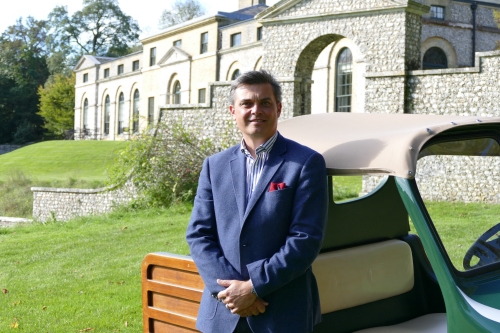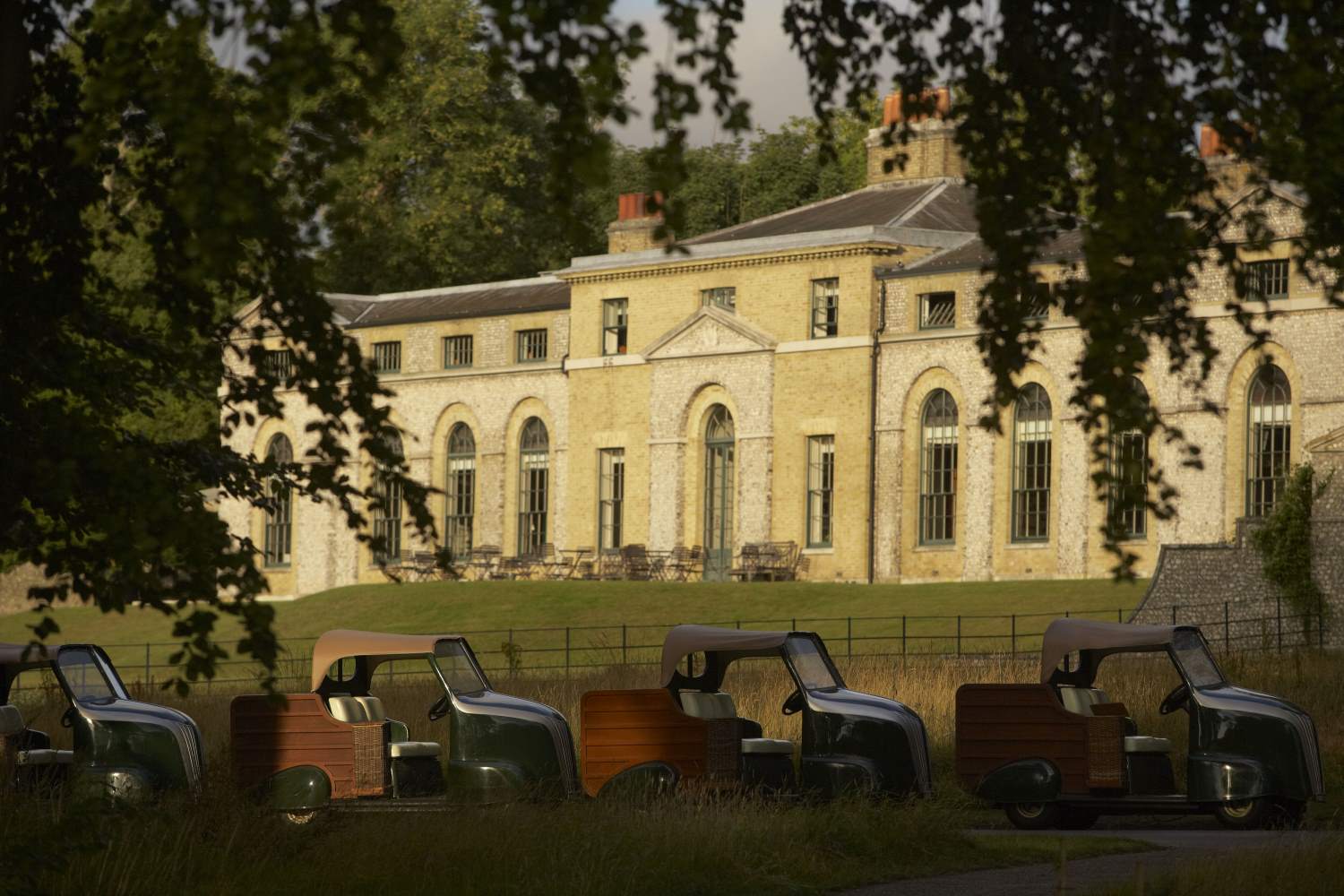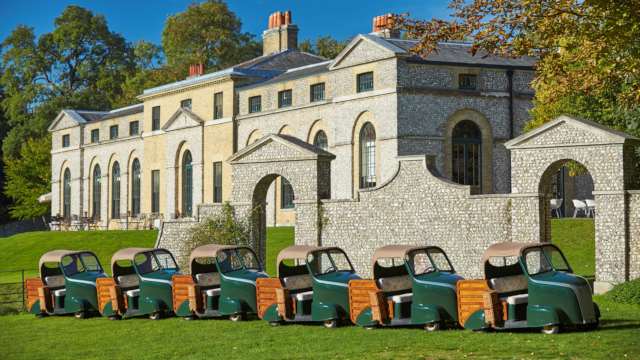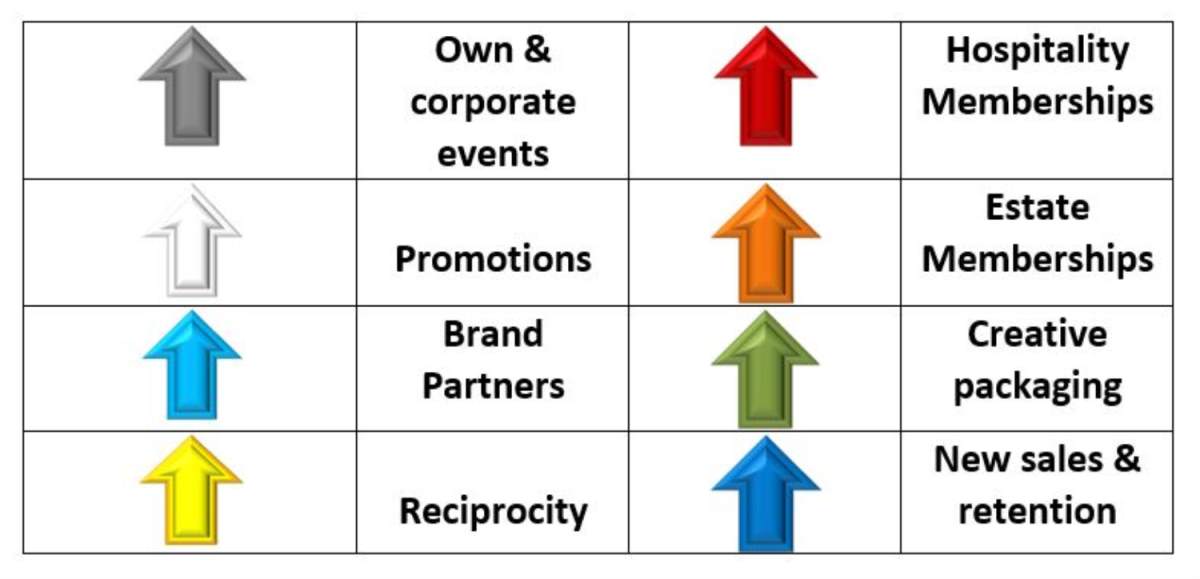Stuart Gillett, General Manager of Golf at Goodwood, in conversation with John Cockayne, the host of our Business of Golf Discussion Series
Stuart Gillett Career Summary

Stuart grew up in Southern Africa and spent his school days, as have many ‘colonials’, as an expat boarder at Sherborne School in Dorset in England.
After studying Recreation & Leisure Management at UWIC in Cardiff (now the Cardiff Metropolitan University) he worked, as many post grad students would like to do, for First Leisure in the Brannigans chain of Bars working his way up to Executive General Manager with responsibility for multiple sites.
In 2003 he decided to take some time out of the UK and spent two very happy ski seasons in Meribel in the French Alps working for the luxury chalet company Meriski as Guest Services Manager.
His early career path has prepared him very well, both in terms understanding the broad strokes and in the delivering the finer details of a hospitality experience at the golf clubs he has subsequently been involved with.
On his return to the United Kingdom in 2005, Stuart harboured the ambition of working in golf. His love for the game started at an early age following his parents on the fairways of the Managa Country Club in Swaziland.
He joined the exclusive Bearwood Lakes Golf Club in Berkshire as the Clubhouse Manager and spent two years there before moving as the G.M. to the nearby Mill Ride Golf & Country Club.
This was followed by an 18 month stint, in the neighbouring county of Oxfordshire, opening the Golf & Leisure club at the stunning Heythrop Park Resort in the role of Director of Golf & Leisure.
In 2011 Stuart took up his current role as the general manager of Golf At Goodwood, where he has overseen the successful growth of the golf business and raised the profile of Golf At Goodwood within the golf industry.

John Cockayne: In the introduction I used the well-worn phrase; ‘If it isn’t broken don’t fix it’ as having very definite relevance in certain areas of business.
We agree however that it does not apply to the business of golf which means that many clubs will need to transition from the ‘old’ revenues’ model.
This will then require answers to three key questions:
Are we as a game, change averse or risk averse?
 Stuart Gillett: We certainly need to be forward thinking in business terms, but I feel that people are naturally averse to change unless they have initiated it themselves, so this supports your comments in the introduction about being proactive and reactive.
Stuart Gillett: We certainly need to be forward thinking in business terms, but I feel that people are naturally averse to change unless they have initiated it themselves, so this supports your comments in the introduction about being proactive and reactive.
If you are being proactive and that is the motivation for the change, then the change is going to more palatable than if it is being forced upon you.
JC: I see people comfortable with making their own calls, but often unable to implement (perhaps they are unwilling!) other people’s ideas or programmes.
This can often be a summary of the lot of a consultant; be contracted in, get paid for an objective appraisal and a proposed solution, deliver it and then sit back to watch it being ignored!
SG: I think that there are three types of change at work in golf:
The changes that you want to make because it is a good idea or can potentially successfully address a problem that is confronting the club.
Changes as a result of other people’s ideas – generally less palatable, but that often can be attributed to human nature!
The third scenario is the one in which the forces demanding the change are external and these will demand change in order for your survival.
There are then two sub-sets to these types of choices: the strategic challenge on finding the ‘right’ path forward and then the practical one in actually implementing the agreed plans.
Personally, I enjoy change because it is exciting and at Goodwood we constantly ask ourselves – are we being innovative and daring enough? But I understand that this environment is not for everyone!
JC: Yes, it is fair to say that most people like to be in their comfort zone – if not, every able-bodied person (and a few who are not!) would probably have already climbed Everest!
But rather like making the move to stop smoking (or climb Everest!) do enough clubs truly realise and acknowledge that any modification to management methodologies will only be the result of a conscious decision to implement change – perhaps we can even liken it to a watershed or Damascene moment?
SG: That moment can indeed be a Damascene, where the needs and the resulting conscious decision to act differently actually take place.
I think that ‘moment’ for Goodwood was less divine and slightly more prosaic.
It was more a case of the owner applying good common business sense as the driver and then rolling up their sleeves with management to design the ‘right’ solution to then be implemented by the management team.
But you are right in that it was a conscious decision none the less to change the way things were done at the golf club.
This it was felt would be good both for the golf operation and help make it fit better within the broader vision for Goodwood.
This bigger vision is about creating a total and unique offering – the ‘magic dust’ that is the Goodwood experience.
Let’s be honest – you don’t have to start a revolution to effect meaningful operational changes, but too many clubs are still mired in the past.
JC: Assuming that we can shake off the shackles of habit and in building for a new future, what key initiatives and approaches should be taken?

SG: I agree with your comment about too many clubs being run on a hand to mouth basis and with no long term vision rather like a corner shop and I think a key problem is attitudinal in that many see the whole concept of the ‘business of golf’ as an alien one and somewhat distasteful.
Too many people see ‘business’ when coupled with golf as being almost a dirty word and closely aligned to its equally odious cousin – ‘commercial’.
This is certainly a perception I have come across in terms of Golf At Goodwood and it is one that I challenge.
Service and member experience are key priorities for us, and it should be obvious that these can only be delivered effectively if the numbers work.
The golf analogy in the introduction about the about the need to set up square to your target line is perfect; the correct alignment in business terms is of equally vital importance.
Golf pro’s won’t think twice about soliciting help from a friend (a fellow pro – in the main) or coach to check their alignment.
This is not a sign of not being able or incompetent, so why is asking for information or help in the golf business seen as being some sort of a weakness and or a sign of being incapable?
Asking for help or support doesn’t mean that you are incompetent or don’t know what you are doing.
JC: So – we agree that good alignment is a key element in hitting the individual shots, but it is also critical in helping to stick to the chosen game plan for the course being played.
We shall have selected the right mix of clubs for the tournament and have decided how best (given our game’s strengths and limitations) to tackle each hole, but this requires planning and forethought.
How many golf clubs and golf estates have ever sat down to work out what their vision is?
SG: I would have to say very few, or if they have the vision or planning is not long term enough.
So to continue your on course playing analogy; they might have thought out how to get through the first 6 holes, but the plan for rest of the round and indeed the other 54 holes (assuming that we make the cut!) is often too long term or just not even considered at all.
Tenures of chairmanships and boards changing can have a serious influence on this as the incumbents will be keen to protect their legacy and won’t want to be associated with a failure, which can lead to nothing new being implemented.
Ironically that can be a good thing if a plan is set and being delivered, but very counter-productive when a plan needs to identified and set on its way!
JC: The Chinese have a number or proverbs, but they also have a 100 year plan. That approach and timeframe does not fit comfortably with standard Western thinking, but in real terms what long term plans should golf clubs have put in place?
For example, what are the timeframes you are using at Goodwood?
SG: We have a rotational three-year plan, but this fits within an overall and broader nine year vision.
That said as we are constantly challenging ourselves to be different and think forward, ideas in this context can alter the longer-term vison especially when it comes to set up times and the implementation of the agreed ideas.
However any changes that are considered need to align with the main vision and fit into the strategic plan.
JC: Part of this change requires clubs to acknowledge that they are in the hospitality industry where golf is a key component but not the whole story.
The second is the need to acknowledge, understand, develop and take pride in the value of the club’s brand.

SG: I couldn’t agree more. The Goodwood brand is a central to our marketing and strategic thinking at all times.
It is a flag or banner that helps encompass our values and vision – we hope that it’s a bit like the Rolls Royce flying lady, or the Apple logo which have become synonymous with quality.
As to hospitality – this has to be a key revenues’ driver going forward provided that each club analyses its market-place and its capability in terms of delivery.
JC: This is very true especially re the analysis and the ‘promise of’ – if any arena benefitted from the philosophy of under promising and over delivering it would be hospitality.
Knowing your market and own limitations, or weaknesses is fundamental intel in this process, so how many clubs are able to answer these questions, or have established customer satisfaction programmes to help identify what problems there may be?
SG: Once again – I think we can safely say almost none. I think that first step is the need to make the conscious decision and acknowledge that golf is in the hospitality space with all that is encompassed by that.
Then the need to understand customers and the importance of profiling will come into much clearer focus.
At the moment little or no attempt is made to capture data with a view to getting a better understanding of the members. With such a lack of real intel or understanding, you have no platform off which to make informed decisions.
As an industry we need to be much more closely connected with our customers (obviously I am including members in this term) so as to know what the customer is thinking.
In many places it seems that we have developed an environment in which he who shouts loudest gets his way!
 JC: We agree that golf needs to transition in a business sense, but I get worried by the superficial understanding of what it will take to achieve some of the goals that are thrown about in discussion at the bar – where else!
JC: We agree that golf needs to transition in a business sense, but I get worried by the superficial understanding of what it will take to achieve some of the goals that are thrown about in discussion at the bar – where else!
A client recently told me that the club’s goal was to become a top 20 ranked course again within two years.
The CFO, who is a friend and a non-golfer, was not sure what this meant, until I put together a short critique of the club’s course’s current status. I included what it would take to achieve this goal so casually bandied about during after golf conversation in the clubhouse. As you can imagine he was shocked at the effort that would be required, the marketing and promotional support needed and the potential costs.
In terms of the latter he was OK as he quickly did a number crunch and could see the end value, but his real shock was centred on how little of this was understood by his estate’s golf committee.
How many clubs are willing, know how to, or have the business patience to innovate in pursuit of long terms goals?
SG: In the recent past I would have to say very few. However, there is now a broad recognition of a need move forward – not only in an academic sense around the strategic design, but also in terms of the implementation
The first step is recognising and accepting the need for change within which there is the need to understand that having the best golf course does not necessarily mean having the best golf club!
JC: This is definitely an important precept, because I have played on so many ‘top’ courses where the rest of the experience was abysmal, from the poor clubhouse facilities to the soggy tasteless pie at the half-way house!
My mantra with my estate clients is that the experience begins at the security gates and thereafter is series of small events (like a string of pearls) from the drive through to the clubhouse, the pick-up at the bag drop, reception in the pro-shop, etc.
How many clubs have really evolved their attitudes and management processes in the past three decades?
SG: This is an area where I believe we are starting to make progress, although the hospitality concept may be still a little down the line for some.
In the main I think that it is driven by the dynamic of younger generation of general managers and that fact that the committees are also getting younger and more progressive. However it is a not about the age of those involved, but rather a willingness to adopt ‘new’ thinking.
JC: I have made reference my experience of too many clubs being essentially reactive as opposed to being proactive.
I used a nautical analogy with a GM recently, when we were discussing a relaunch of an estate, where we would be today if Columbus had taken the ‘safe’ route and just stayed moored in the harbour instead of pushing the boat out!?
As agreed much of this ‘safety first’ attitude can be attributed to changing committees protecting their legacy, but then I am often surprised when having agreed to make the changes the client will reference ‘innovative’, forward thinking’ clubs that the client club would like to be like.
Just getting the client over this watershed was my goal so I don’t want to get ‘picky’ and point out that their benchmark clubs are often far from being innovation or entrepreneurial, when in fact most are just applying common sense and doing the business 101 correctly.
Are the clubs touted as being successful, innovative and forward thinking actually any these, or merely clubs doing what everyone else should be doing i.e. the 101 in a business sense?
 SG: In generic terms no. However, to get a more accurate reflection on this assessment from club to club you would need to factor in the type of club; have they assessed and aligned themselves with the business opportunities most fitted to their facilities, their location, etc.
SG: In generic terms no. However, to get a more accurate reflection on this assessment from club to club you would need to factor in the type of club; have they assessed and aligned themselves with the business opportunities most fitted to their facilities, their location, etc.
Sunningdale’s core offering for example hasn’t actually changed, but they have refined and polished the product very effectively.
Membership acquisition and retention will remain a key goal for everyone going forward.
As I stated earlier, at Goodwood as a management team are we are constantly asking ‘are we being brave enough’, ‘are we being foolhardy’, ‘are we listening enough’, etc.
JC: In an upcoming discussion titled ‘Back to the Chalkboard’, we shall deal with education in more detail.
At this point and in your experience are clubs’ management teams properly equipped to face the challenges posed by a new trading environment?
SG: We are certainly trying to share more; the example I gave you of my little group where we meet to discuss issues, etc. might be indicative of this change.
This discussion series offers an ideal platform to debate; discuss problems, exchange ideas, etc.
We really need to break down the silos as many managers can get isolated and sharing knowledge and experiences should not be seen, as I stated previously, as a sign of weakness.
JC: Just to summarise the points made in the introduction: for many years and while the golf industry enjoyed the really ‘good times’, through the growth the game experienced from the 1960’s to the end of the 1990’s, the industry trained its management and professionals to possess skill sets which were very largely custodial.
The then finally and perhaps inevitably the traditional revenue model turned turtle as costs overtook revenues leaving the question – what steps and initiatives would be required to right the ship??
A key first step must be to analyse the market place and the facility’s assets and its capability to deliver new services or existing services better and develop new products and extended services with the marketing initiatives to take both the message and new products to the market place.
In this example shown below the grid relates at to an actual client solution and in this case under the ‘brand partners’ section, the relationship with one new partner took this particular operation into the trading black for the first time in its 20 year history.

These were specific to the needs of a particular golf estate, but in broader terms is this the right approach for golf clubs?
 SG: Without a shadow of a doubt; making sure that the business mix is right, which is what you have done for this client, is a key step.
SG: Without a shadow of a doubt; making sure that the business mix is right, which is what you have done for this client, is a key step.
As we agreed there is no one size fits all solution to this and each facility needs to ask itself questions and look at the possible solutions based on their specific merits and any limitations that the club might have i.e. in terms of bricks and mortar, location, etc.
Often you won’t have to look far from ‘home’ provided you ask the right questions:
- What is the club’s core business and is it being fully exploited?
- Look at options, because how do you know that you have the right business model unless you are prepared to explore and innovate?
- If we are in a hospitality environment then shouldn’t this help us sell more social memberships?
- Is the membership mix and structure right?
JC: Thanks Stuart – these sound like just the type of ongoing questions you and your team are asking of yourselves and Goodwood, and the answers to all of these questions will give any management team a much better understanding of their club’s limitations and more importantly its potential for growth.
To round off this discussion topic, next week we shall be talking with Francois Schoeman (COO of GEMS Property Management Services) in South Africa.
This will give us broader view of those same discussued with Stuart at Goodwood albeit across multiple estates and golf facilities.

